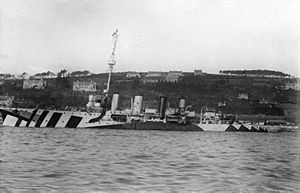 Active at anchor in dazzle camouflage
| |
| History | |
|---|---|
| Name | HMS Active |
| Builder | Pembroke Royal Dockyard |
| Laid down | 27 July 1910 |
| Launched | 14 March 1911 |
| Commissioned | December 1911 |
| Fate | Sold for scrap, 21 April 1920 |
| General characteristics (as built) | |
| Class and type | Active-class scout cruiser |
| Displacement | 3,340 long tons (3,390 t) (normal) |
| Length | 405 ft (123.4 m) (o/a) |
| Beam | 41 ft (12.5 m) |
| Draught | 14 ft 6 in (4.4 m) |
| Installed power |
|
| Propulsion |
|
| Speed | 25 knots (46 km/h; 29 mph) |
| Range | 4,630 nautical miles (8,570 km; 5,330 mi) at 10 knots (19 km/h; 12 mph) |
| Complement | 293 |
| Armament |
|
| Armour |
|
HMS Active was the name ship of her class of three scout cruisers built for the Royal Navy in the 1910s. Completed in 1911, she was briefly assigned to several different units until the ship became the flotilla leader of the 2nd Destroyer Flotilla (DF) in 1914. When the First World War began in August of that year, the 2nd DF was assigned to the Grand Fleet where their primary task was to protect the fleet from submarines.
By the beginning of 1916, Active was assigned to the Grand Fleet and played a minor role in the Battle of Jutland later in the year. Shortly afterwards, she was briefly assigned as the flotilla leader of the 4th Destroyer Flotilla and escorted the main body of the Grand Fleet during the action of 19 August. By the end of the year, the ship was assigned to the Dover Patrol and was present during two battles with German destroyers, but was not engaged in either. Active was based in Ireland by the beginning of 1918, but was soon transferred to the Mediterranean Fleet and based in Gibraltar for the rest of the war. The ship was reduced to reserve in 1919 and was sold for scrap the following year.
